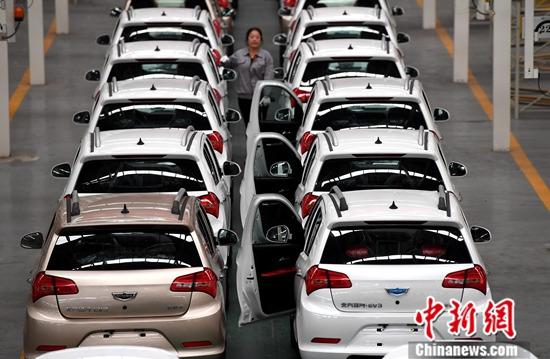(Economic Watch) Can China's new energy vehicles still buck the market and become more popular?
China News Service, Shanghai, January 22 (Zhou Zhuao) After three consecutive years of decline, China's auto market will usher in positive growth again in 2021.
Among them, 3.545 million new energy vehicles were produced and 3.521 million were sold, contributing a huge force to the growth of the auto market.
However, entering 2022, new energy vehicle companies have announced price increases one after another.
On the evening of the 21st, BYD officially announced that it would adjust the official guide price of its related new energy models, ranging from 1,000-7,000 yuan.
In addition to BYD, FAW-Volkswagen, Tesla, Nezha Automobile, Xiaopeng Automobile, GAC Aian and other new energy car companies have also announced price increases before.
Data map: New energy vehicle production line.
Photo by China News Agency reporter Zhang Bin
In fact, the price increase of new energy vehicles is not unexpected.
At the end of 2021, the Ministry of Finance and other four ministries and commissions issued the "Notice on the Promotion and Application of Financial Subsidy Policies for New Energy Vehicles in 2022". The car purchase subsidy policy will be terminated on December 31, 2022, and the subsidy will no longer be given to vehicles registered after December 31, 2022.
At the same time as the subsidy declines, the price of raw materials for new energy vehicles has ushered in a sharp rise.
According to statistics, the spot price of lithium metal will increase by as much as 175% in 2021, and the average price of battery-grade lithium carbonate will increase by more than 418%. Since 2022, the price of battery-grade lithium carbonate has continued to hit new highs.
The Lithium Battery Research Institute of the High-tech Industrial Research Institute estimates that due to the increase in the price of raw materials, the theoretical cost of cells and battery systems will increase by more than 30%.
As the subsidy policy enters the last year, various preferential policies are gradually reduced, raw material prices have risen, and the chip shortage crisis has not been resolved. Can more expensive new energy vehicles continue their hot performance in 2021 in 2022?
Guohai Securities pointed out in a recent research report that the retreat was clearly mentioned in the new energy vehicle subsidy notice issued in April 2020. Therefore, many consumers buy in advance to lock in discounts, and they are not interested in future car prices. There are certain psychological expectations.
Guohai Securities believes that China's new energy vehicle market has shifted from policy-driven to market-driven. In the face of strong downstream demand, the decline of subsidies will have a limited impact on the overall market growth of new energy vehicles. In the future, the overall new energy vehicle will still show a state of steady growth.
Cui Dongshu, secretary-general of the National Passenger Vehicle Market Information Association (referred to as: Passenger Vehicle Association), said that with the implementation of new energy subsidies, the price of some models has been fine-tuned, and consumer mentality has also changed, and the demand for new energy vehicles will still be slightly affected.
However, new energy vehicles continue to be popular, and there is currently a backlog of undelivered orders in the early stage, so the sales of most new energy vehicles will not be significantly affected by the decline.
In Cui Dongshu's view, as the scale increases, the cost will inevitably drop gradually, and the new energy subsidy will continue until the end of 2022, and its cost-reducing effect will be obvious, driving the upgrade of A00-class models (mini cars) and the main A-class models. (Compact car) breakthrough.
Shengang Securities analyst Cao Xute believes that the subsidy policy has completed its historical mission of cultivating the market in the early stage, and China's new energy vehicles have entered a period of rapid development. At present, new energy vehicles have entered the "demand-led" stage from "price-led". , Compared with the price, consumers value the experience and convenience of new-energy vehicles in terms of license plates, travel restriction policies, and electric intelligent functions.
It is worth mentioning that the "Notice on the Promotion and Application of Financial Subsidy Policies for New Energy Vehicles in 2022" mentioned that the current technical indicator system framework and threshold requirements for purchase subsidies will remain unchanged in 2022.
In this regard, the Passenger Federation believes that the new energy subsidy policy in 2022 is a huge benefit. In 2022, the current purchase subsidy technical indicator system framework and threshold requirements will remain unchanged, and the subsidy scale will not be locked from the original expected 2 million subsidy scale. , which will be subsidized throughout 2022.
Although the amount of subsidies has been reduced after the New Deal, the amount of subsidies has been expanded accordingly.
The China Passenger Car Association has also raised its sales target for new energy passenger vehicles in 2022. It was originally expected to sell 4.8 million new energy passenger vehicles in 2022, but it should now be adjusted to more than 5.5 million, and the penetration rate of new energy passenger vehicles will reach 25%. about.
The number of new energy vehicles is expected to exceed 6 million, and the penetration rate of new energy vehicles is around 22%.
(Finish)

